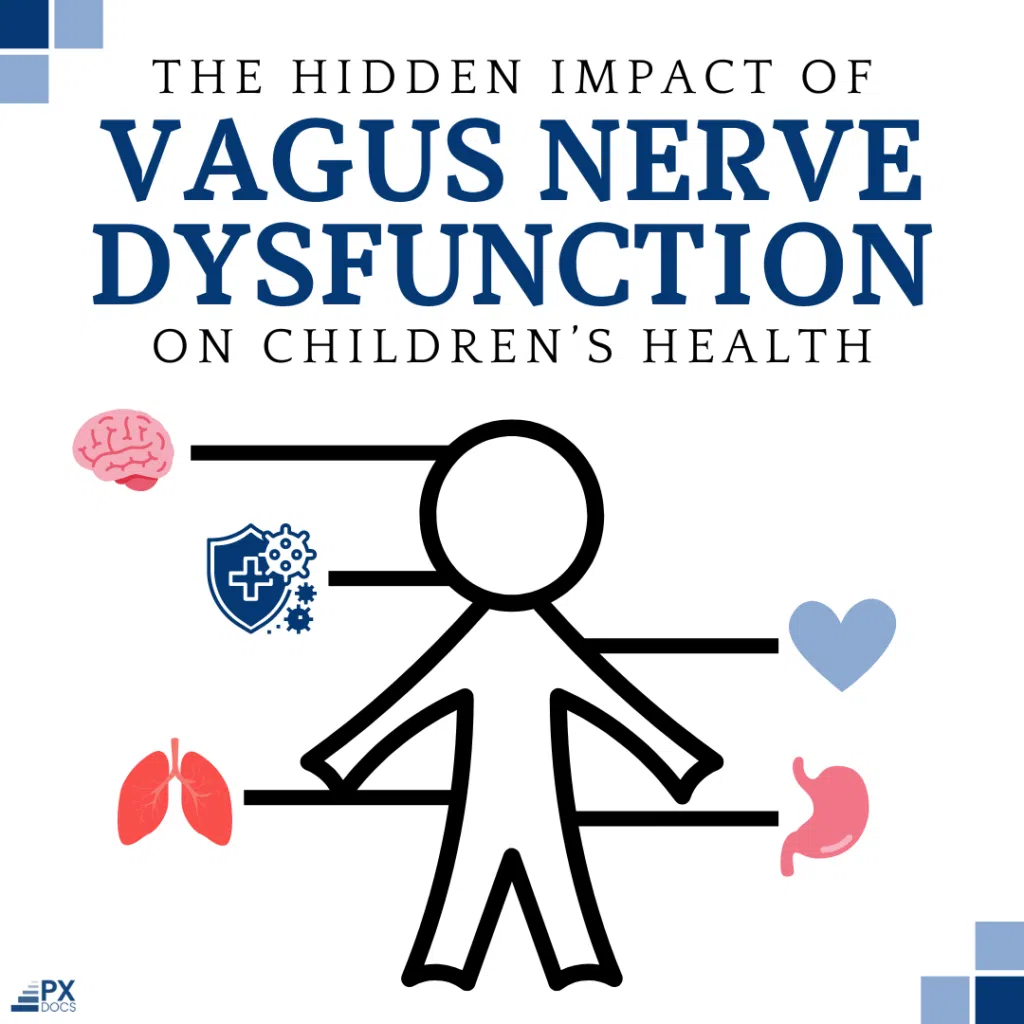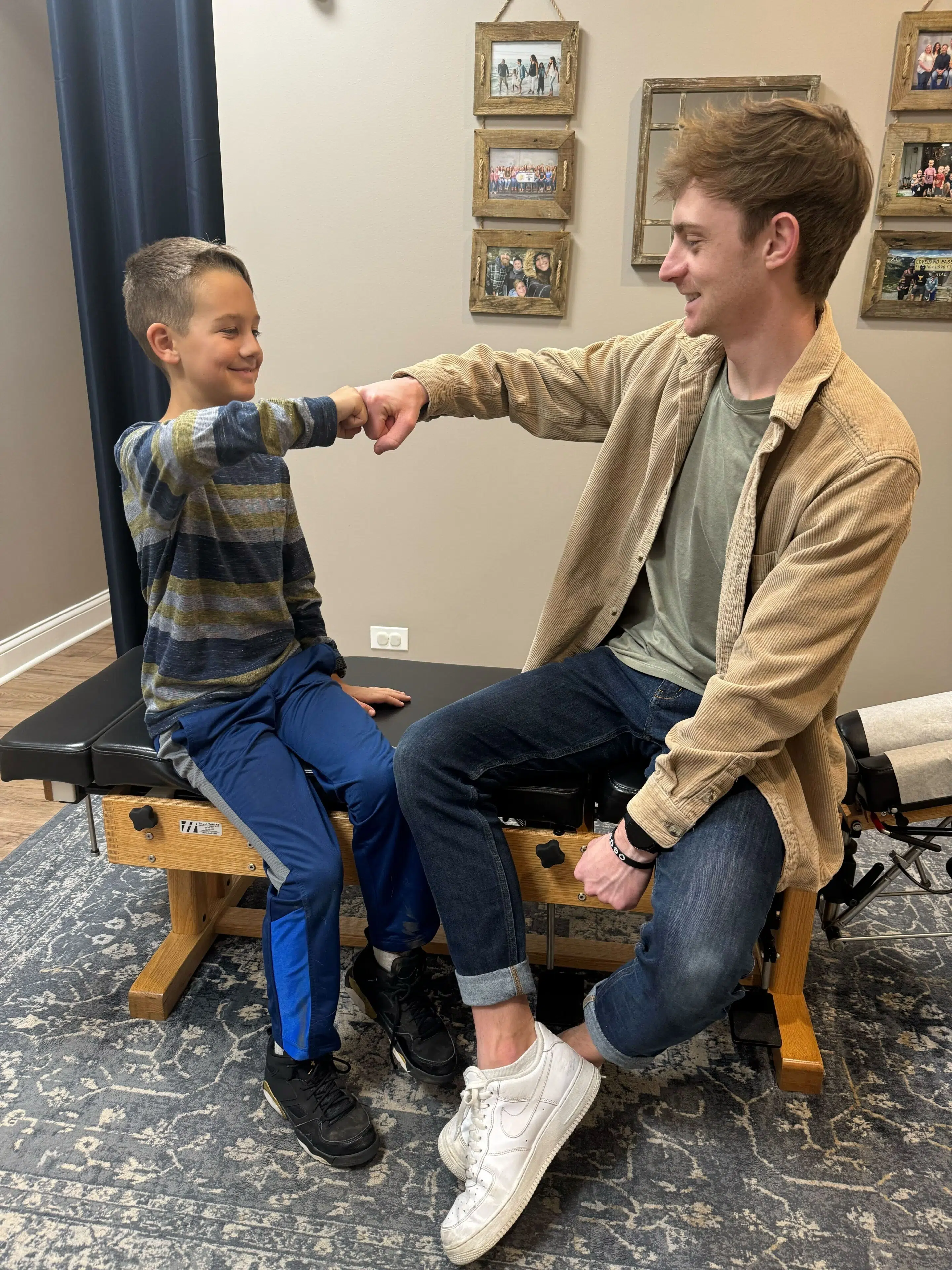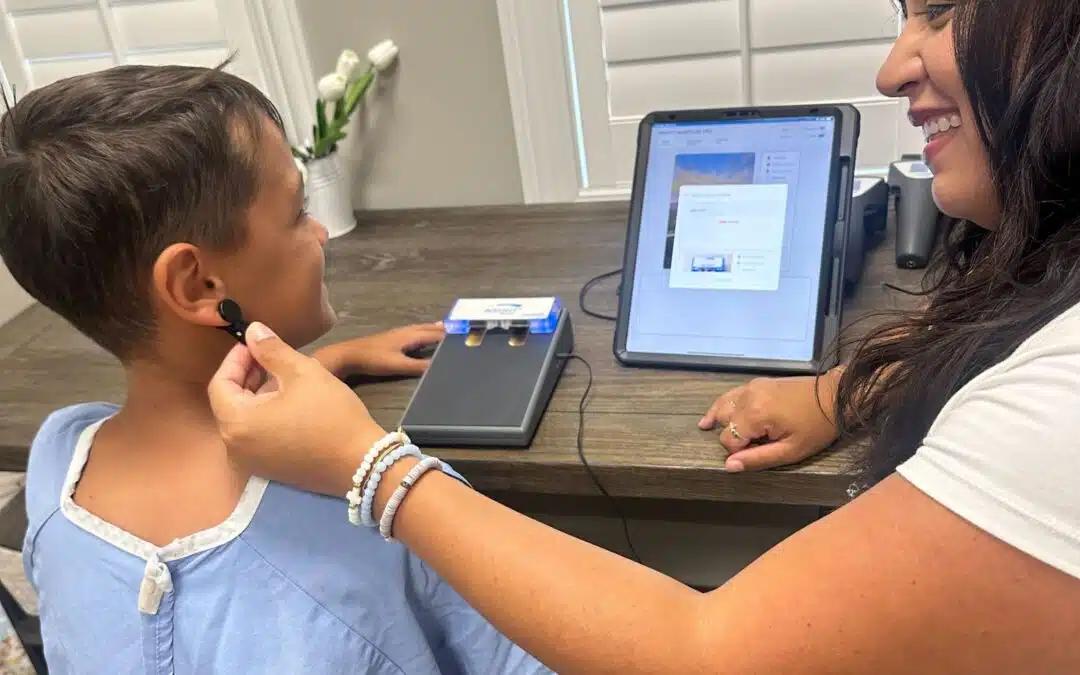Over the past few decades, life-changing diagnoses like autism, ADHD, anxiety, asthma, and allergies have rapidly increased in children. Genetics and lifestyle factors play a role, but clinical evidence increasingly points to the central nervous system as a root cause agent.
Specifically, the vagus nerve—the master parasympathetic nerve responsible for regulating digestion, breathing, and inflammation—often faces disruption from cumulative stresses like prenatal distress, birth trauma, infections, toxins, and emotional anxiety. This “Perfect Storm” of factors can lead to vagus nerve dysfunction, manifesting vaguely at first but potentially progressing to more serious developmental, behavioral, and gut disorders over time if the underlying nerve imbalance remains unaddressed.
Yet, the profound mind-body connections coordinated by the vagus nerve are still overlooked all too often. When children exhibit neurological, chronic, or mood issues, the standard focus centers on treating individual symptoms only instead of assessing and correcting nervous system dysregulation as the underlying, interconnected cause allowing symptoms to manifest and persist.
Rebalancing nervous system communication and restoring optimal vagus nerve function, releasing stress and subluxation through Neuro-Tonal chiropractic adjustments offers the potential to alleviate many of these challenging conditions safely and effectively rather than perpetual suppression via medications. Understand what may be affecting your child’s vagus nerve function and how tailored, drug-free solutions can help unlock their fullest healing potential.
What is the Vagus Nerve?
Also known as the “wandering” or “pneumogastric” nerve, the vagus nerve represents the longest and most complex nerve of the 12 cranial nerves linking the brain to the rest of the body. This remarkable nerve originates at the brainstem and then winds its way down through the neck, chest, and abdomen—interfacing along its route with vital organs like the heart and lungs as well as digestive structures.
As the primary nerve constituting the parasympathetic division of the autonomic nervous system, the vagus nerve facilitates relaxation, digestion, healing, and other restorative functions associated with the “rest and digest” response.
A properly functioning vagus nerve allows the body to effectively moderate reactions to stressors by calming heart rate, damping destructive inflammation, and generally maintaining homeostasis.
Beyond controlling vital signs and digestive health, the vagus nerve also exerts influence over immune regulation, mood balance, sociability, and speech capabilities—which explains how its imbalance can promote other vagus nerve disorders not just in the gut but also in the brain and nervous system at large. Communicating bidirectionally with gut microbes through the all-important gut-brain axis feedback loops, the vagus nerve works tirelessly behind the scenes to maintain equilibrium and optimal wellness throughout the entire body.
Where Is the Vagus Nerve Located?
The vagus nerve originates in the brainstem and extends throughout multiple regions of the body. After exiting the skull, this long nerve passes through the neck, chest, and abdomen, interfacing with vital organs along its route.
Once it leaves the medulla oblongata, the vagus nerve divides into two branches—the left vagal nerve and the right vagal nerve. The left vagal nerve travels down the left side of your neck, while the right vagal nerve travels down the right side. This nerve is a long one, stretching from your brain to your large intestine. It passes through your neck, chest, heart, lungs, abdomen, and intestines.
Vagus Nerve Damage
Vagus nerve damage, also called dysfunction, can result in impaired communication between the brain and body, leading to diverse effects across multiple systems that the vagus nerve interfaces with. Consequences of impaired vagal signaling include:
- Digestive issues
- Cardiovascular problems
- Respiratory dysfunction
- Mental health
- Difficulty swallowing, impaired gag reflex
- Sleep disorders
- Headaches, migraines
- Hormonal imbalances
Yet, when accumulating “Perfect Storm” stressors from conception through childhood overwhelm the developing nervous system’s natural resilience, injury and dysfunction inevitably occur. The ensuing impaired vagus nerve signaling and regulation fails to allow the body to recover properly, contributing greatly to the dramatic rises in inflammatory, immune, and chronic disorders among children.
Without a doubt, not only is vagus nerve dysfunction the most overlooked aspect of healthcare overall, but the reality of birth trauma being the most common original trigger or cause of vagus nerve dysfunction is really what needs to be talked about and researched so much more. Millions and millions of infants every year are born via interventions that put immense physical strain, tension, and trauma directly to the delicate brainstem and vagus nerve area. This level of physical injury and trauma to the vagus nerve can have lasting effects if not discovered and properly cared for by a trained Neurologically-Focused Pediatric Chiropractor.
Vagus Nerve Dysfunction Explained
When the vagus nerve cannot appropriately regulate key bodily functions under its domain, the resulting inadequate activity is termed vagus nerve dysfunction or dysautonomia in clinical contexts.
Vagus dysfunction frequently manifests after physical injury from trauma scenarios like birth interventions, severe infections, surgery complications, and more, which damage the intricate anatomical structures the vagus nerve relies upon. High levels of psychological stress over prolonged periods can also compromise the vagus—as can toxin exposures and chronic inflammation.
However, science now suggests that subluxation disrupting communication between the brain, vagus nerve, and end organs may be detectable in a majority of clinically confirmed cases of dysautonomia and vagal control dysfunction. These upper cervical spinal segment misalignments place pressure on nerves exiting the brainstem towards end organs, contributing greatly to functional and regulation issues.

The primary aspects of health and wellness impacted by vagus nerve dysfunction include:
- Digestion: Delayed gastric emptying and impaired gut motility lead to symptoms like abdominal bloating, nausea and vomiting, visceral pain, and constipation. In clinical contexts, these manifestations fall under conditions like gastroparesis and inflammatory bowel disease when severe and chronic.
- Cardiovascular Function: Both abnormally high resting heart rates and orthostatic hypotension signs reflect compromised vagus nerve activity and can lead to syncope episodes.
- Inflammation: Since the vagus nerve regulates key anti-inflammatory pathways, low vagal tone prevents the body from resolving inflammatory responses properly—linking dysfunction to increased risks of allergies, certain autoimmune conditions, and stubborn subacute infections.
- Respiration: Vagus nerve problems can translate into issues appropriately modulating breathing rate and efficiency, leading to conditions like vocal cord weakness, chronic dry cough, and asthma attacks.
- Mood Regulation: Chronic exposure to high-stress levels paired with reduced vagus nerve activity to produce calming neurotransmitters is strongly associated with mental health and mood disorders like anxiety and depression.
Signs and Symptoms of Vagus Nerve Dysfunction
Because the vagus nerve interacts with diverse regions, the signs of impaired function can remain vague initially, with common digestive annoyances, rapid resting heart rate, and dizziness upon standing representing few overt clues that patients and parents may notice.
Here are some key symptoms tied to areas where the vagus nerve is known to exert control:
- Neck, Ears, and Throat: Hoarse voice, slurred or monotonous speech, difficulty swallowing, impaired gag reflex
- Respiratory: Shortness of breath, rapid shallow breathing, vocal cord spasms, dry nagging cough
- Cardiovascular: Inappropriately rapid resting heart rate, orthostatic hypotension and dizziness, heart palpitations, vasovagal syncope
- Gastrointestinal: Heartburn, nausea, vomiting undigested food, early satiety, abdominal bloating, cramping, constipation, and, or diarrhea
- Nervous System: Depression, anxiety, panic attacks, emotional lability, poor stress tolerance
When children suffer from unresolved digestive troubles, chronic inflammation, or mood issues, assessing for potential underlying vagus nerve problems can provide valuable insights, as impaired signaling of this critical neurological pathway often links these outward symptoms.
Vagus Nerve Stimulation
Vagus nerve stimulation (VNS) is a therapy that uses mild electrical pulses to stimulate the vagus nerve. A small device is implanted in the body, with a connecting wire sending signals to the vagus nerve in the neck.
The signals transmitted via VNS have been shown to help restore balanced signaling in the nervous system. The Food and Drug Administration has approved VNS for treating epilepsy and hard-to-treat depression. Ongoing research indicates VNS may also benefit patients with:
- Inflammatory conditions like rheumatoid arthritis by damping inflammation
- Digestive disorders like irritable bowel disease by improving gut motility and function
- Migraine headaches by stabilizing key neurotransmitters
- Alzheimer’s disease by stimulating better memory function
- Autism spectrum disorders by enhancing social engagement and flexibility
Though still an emerging therapy, VNS shows immense promise as an alternative medical option to pharmaceutical drug use for these various hard-to-treat chronic conditions.
However, after seeing hundreds of patients clinically myself who previously had vagus nerve stimulators implanted to treat their seizures, it’s likely that the long term clinical benefit will be marginal at best. Most of my patients who have VNS stimulators no longer have them active or use them at all, because just like outside-in medications, the body becomes immune to this unnatural stimulation of the vagus nerve over time.
The future of vagus nerve stimulation and using it to care for chronic health conditions therefore must rely primarily on truly natural, physical, and innate forms of vagus nerve stimulation like neurologically-focused chiropractic adjustments and other options discussed here in this article and on our site.
Why Assessing Vagus Nerve Function Matters
Since the vagus nerve regulates so many crucial aspects of health and nervous system balance, assessing its functional status represents a pivotal first step when supporting children exhibiting complex neurological, developmental, or behavioral conditions.
Advanced assessment using state-of-the-art, non-invasive metrics focused on objectively gauging nervous system stress like Heart Rate Variability, and other proprietary INSiGHT scans can provide accurate and quantifiable measurements of key aspects like parasympathetic tone, nerve pathway flexibility, and electrical signaling conductivity.
These scans allow our PX Docs network of neurologically-focused pediatric chiropractors to reveal the presence of subluxation that may be causing or contributing to a child’s symptoms – rather than just temporarily alleviating those symptoms with medications. They additionally supply objective markers to track progress throughout care.
Once a PX Doctor has these scans, we can then pinpoint and decide both the best adjusting techniques that will get the patient optimal results, as well as what regions and areas our adjustments need to focus on first. Nearly every single time, the first phase of our neurologically-focused chiropractic adjustments focuses on the areas that best stimulate the vagus nerve and parasympathetic nervous system tone in order to activate the healing, restoring, and regulating side of the nervous system first.
As care progresses, many patients also find benefit in nutritional support, stress-reduction coaching, prayer or meditation, and certain forms of exercise known to stimulate the vagus nerve, such as going for a walk in nature or practicing yoga.
Progress over an appropriate course of care further validates success through demonstrable and objective serial Heart Rate Variability scan changes, which reflect notable improvements in autonomic regulation and balanced, flexible nervous system activity – perhaps the single most pivotal marker of sustainable wellness according to modern scientific literature.
If your child faces developmental, behavioral, or chronic health issues that have proven difficult to resolve through conventional symptom suppression approaches alone, check out our directory and contact a PX Doc chiropractor today to inquire about Advanced Neurological Assessment and customized solutions. Determining any underlying vagus nerve dysfunction or nervous system imbalance causing symptoms provides immense clinical value in directing proper solutions to address the origins rather than just the effects. With dedicated support and Neurologically-Focused personalized care, there is always hope for your child’s well-being and a brighter future ahead.





